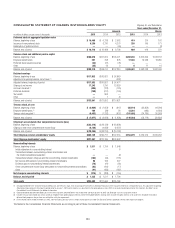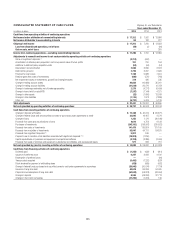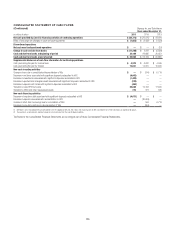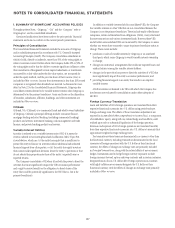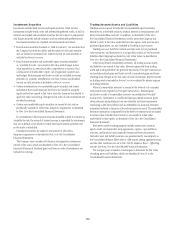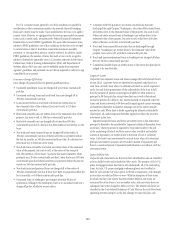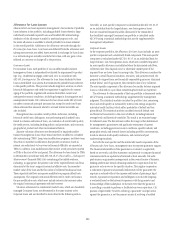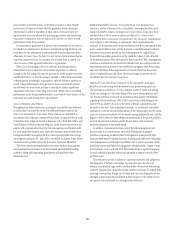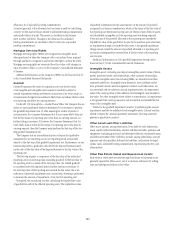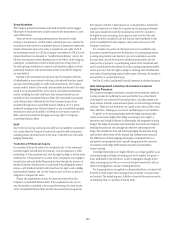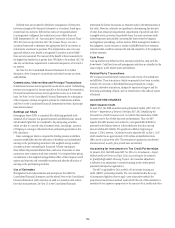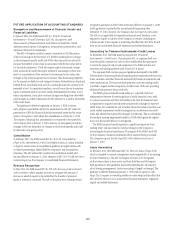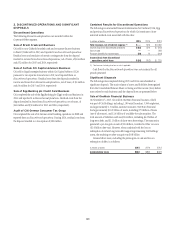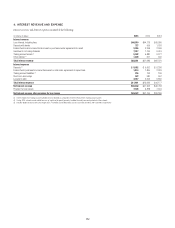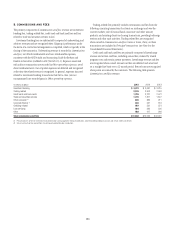Citibank 2015 Annual Report Download - page 161
Download and view the complete annual report
Please find page 161 of the 2015 Citibank annual report below. You can navigate through the pages in the report by either clicking on the pages listed below, or by using the keyword search tool below to find specific information within the annual report.143
Allowance for Unfunded Lending Commitments
A similar approach to the allowance for loan losses is used for calculating
a reserve for the expected losses related to unfunded lending commitments
and standby letters of credit. This reserve is classified on the balance
sheet in Other liabilities. Changes to the allowance for unfunded
lending commitments are recorded in the Provision for unfunded
lending commitments.
Mortgage Servicing Rights
Mortgage servicing rights (MSRs) are recognized as intangible assets
when purchased or when the Company sells or securitizes loans acquired
through purchase or origination and retains the right to service the loans.
Mortgage servicing rights are accounted for at fair value, with changes in
value recorded in Other revenue in the Company’s Consolidated Statement
of Income.
Additional information on the Company’s MSRs can be found in Note 22
to the Consolidated Financial Statements.
Goodwill
Goodwill represents the excess of acquisition cost over the fair value
of net tangible and intangible assets acquired. Goodwill is subject to
annual impairment testing and between annual tests if an event occurs or
circumstances change that would more-likely-than-not reduce the fair value
of a reporting unit below its carrying amount.
Under ASC 350, Intangibles—Goodwill and Other, the Company has an
option to assess qualitative factors to determine if it is necessary to perform
the goodwill impairment test. If, after assessing the totality of events or
circumstances, the Company determines that it is not more-likely-than-not
that the fair value of a reporting unit is less than its carrying amount, no
further testing is necessary. If, however, the Company determines that it is
more-likely-than not that the fair value of a reporting unit is less than its
carrying amount, then the Company must perform the first step of the two-
step goodwill impairment test.
The Company has an unconditional option to bypass the qualitative
assessment for any reporting unit in any reporting period and proceed
directly to the first step of the goodwill impairment test. Furthermore, on any
business dispositions, goodwill is allocated to the disposed business based
on the ratio of the fair value of the disposed business to the fair value of the
reporting unit.
The first step requires a comparison of the fair value of the individual
reporting unit to its carrying value, including goodwill. If the fair value of
the reporting unit is in excess of the carrying value, the related goodwill
is considered not to be impaired and no further analysis is necessary. If
the carrying value of the reporting unit exceeds the fair value, this is an
indication of potential impairment and a second step of testing is performed
to measure the amount of impairment, if any, for that reporting unit.
If required, the second step involves calculating the implied fair value
of goodwill for each of the affected reporting units. The implied fair value
of goodwill is determined in the same manner as the amount of goodwill
recognized in a business combination, which is the excess of the fair value of
the reporting unit determined in step one over the fair value of the net assets
and identifiable intangibles as if the reporting unit were being acquired.
If the amount of the goodwill allocated to the reporting unit exceeds the
implied fair value of the goodwill in the pro forma purchase price allocation,
an impairment charge is recorded for the excess. A recognized impairment
charge cannot exceed the amount of goodwill allocated to a reporting unit
and cannot subsequently be reversed even if the fair value of the reporting
unit recovers.
Additional information on Citi’s goodwill impairment testing can be
found in Note 17 to the Consolidated Financial Statements.
Intangible Assets
Intangible assets, including core deposit intangibles, present value of future
profits, purchased credit card relationships, other customer relationships,
and other intangible assets, but excluding MSRs, are amortized over their
estimated useful lives. Intangible assets deemed to have indefinite useful
lives, primarily certain asset management contracts and trade names, are
not amortized and are subject to annual impairment tests. An impairment
exists if the carrying value of the indefinite-lived intangible asset exceeds its
fair value. For other intangible assets subject to amortization, an impairment
is recognized if the carrying amount is not recoverable and exceeds the fair
value of the intangible asset.
Similar to the goodwill impairment analysis, in performing the annual
impairment analysis for indefinite-lived intangible assets, Citi may and has
elected to bypass the optional qualitative assessment, choosing instead to
perform a quantitative analysis.
Other Assets and Other Liabilities
Other assets include, among other items, loans held-for-sale, deferred tax
assets, equity method investments, interest and fees receivable, premises and
equipment (including purchased and developed software), repossessed assets,
and other receivables. Other liabilities include, among other items, accrued
expenses and other payables, deferred tax liabilities, and reserves for legal
claims, taxes, unfunded lending commitments, repositioning reserves, and
other matters.
Other Real Estate Owned and Repossessed Assets
Real estate or other assets received through foreclosure or repossession are
generally reported in Other assets, net of a valuation allowance for selling
costs and subsequent declines in fair value.



